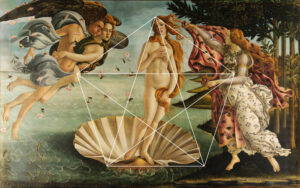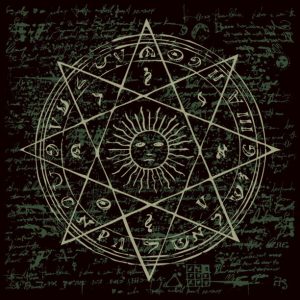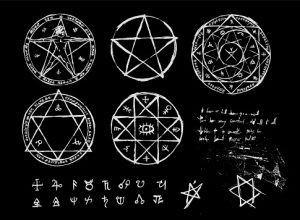As the descent of twilight is experienced, there might be an inclination to gaze upon the stars, sketching out patterns and constellations that have held humanity’s fascination for millennia. Among the most iconic shapes to be conjured in the mind’s eye is the five-pointed star, or the pentagram. Throughout the ages and across various cultures, this star has been revered as a symbol of mysticism, magic, and spiritual understanding; and often with the practices of witchcraft.
The Birth of the Pentagram
The ancient symbol known as the pentagram can trace its roots back to the dawn of human civilization. Its first-known inscription has been discovered on pottery shards originating from the Sumerian civilization. Sumerians are one of the earliest human societies known to have existed in the ancient Near East, around 3000 BC. The pentagram was utilized by them as a pictogram, a representation of the heavens’ differing directions.

In the world of ancient Greece, the pentagram was held in high regard by the Pythagoreans as a symbol of mathematical perfection. The golden ratio, a mathematical proportion believed to hold the key to comprehending the structure of the universe, was embodied by the five-pointed star. The pentagram was even identified by the Pythagoreans as a symbol of health, known as “Hygieia,” named in honor of the Greek goddess of health.
Pentagram as a Universal Key
The reason the pentagram is such an important and commonly encountered symbol is that it best represents the principle of quaternity, which holds a significant place in all cultures. The pentagram indicates the four elements and the four directions. Four is therefore considered a material number and brings completeness.

Ancient teachings believe that if a person can flow into every aspect of life and the four elements, they can access all knowledge of the universe. However, creation can occur only through the amalgamation of these four elements. The fifth element is the spirit, ether, or essence, which is separate from the material world and belongs to the celestial realm. In short, with its five points, the pentagram is the key to both the material and celestial worlds, symbolizing dominion over all four directions as well as both realms.
Evolution of the Symbol
Across various cultures, the pentagram has been frequently associated with elemental forces. According to Chinese tradition, the pentagram’s five points symbolize the five elements: Wood, Fire, Earth, Metal, and Water. Similarly, each point of the pentagram is tied to one of the four elements — Earth, Air, Fire, and Water — in Western occult tradition, with the fifth point symbolizing Spirit or Ether, the element that transcends the physical realm.
The Unfortunate Misinterpretation of the Pentagram
Long revered as a symbol of harmony and unity, the pentagram has been subject to misunderstanding and misrepresentation, particularly in its portrayal within popular culture. The 19th-century saw a significant shift in the symbol’s representation when Eliphas Levi, a French occult author and ceremonial magician, depicted an inverted pentagram with a goat’s head inscribed within it. This depiction was later linked with Baphomet, a deity the Knights Templar were falsely accused of worshiping, and eventually became symbolic in certain occult and satanic practices.

An inverted pentagram, with two points projecting upwards, is perceived by some as a symbol of defiance and rebellion against heavenly forces, leading to its association with Satanism. This misinterpretation has been fueled further by Anton LaVey, founder of the Church of Satan, who adopted an inverted pentagram as their official insignia, known as the Sigil of Baphomet, solidifying the connection between the pentagram and satanic symbolism in the public eye.

However, it’s important to highlight that this connection does not reflect the symbol’s rich and multifaceted history. Many practitioners of non-Satanic paths continue to use the upright pentagram as a symbol of balance and protection. As with any symbol, understanding its true meaning and use requires a consideration of context and intent.
The Pentagram in Contemporary Witchcraft
In the present day, the pentagram is commonly linked with witchcraft, paganism, and Wicca, serving as both a sacred tool and a symbol of faith.
Within these traditions, the pentagram is generally viewed as a symbol of the interconnectedness of all things, with its five points representing Spirit and the four elements of Earth, Air, Fire, and Water. The continuous, unbroken lines of the symbol reflect the unity of all aspects of life and the surrounding world.

It is common for witches and Wiccans to incorporate the pentagram in their rituals and magical workings. The pentagram might be drawn in the air with a wand or athame (a ceremonial knife) to consecrate sacred space, invoke elemental energies, or symbolize a connection with the divine.
The pentagram may also be adorned as jewelry, serving as a protective amulet and a declaration of spiritual identity. This symbol might be inscribed on ritual tools such as altar cloths, chalices, or spell books, imbuing its powerful symbolism into the magical workings of the practitioner.
However, it is crucial to bear in mind that the relationship each practitioner has with the pentagram may vary. It is a deeply personal symbol, and its interpretation can significantly differ based on an individual’s beliefs, traditions, and experiences.

The Pentagram’s Ongoing Journey
From ancient Sumerians to the modern witch, the pentagram has stood as a symbol of cosmic harmony. This ageless symbol continues to inspire and intrigue, carrying the echoes of the past while remaining a consistent presence in many individuals’ spiritual journeys today.
As always, respect for the past should be maintained, the present should be lived fully, and the future should be anticipated by looking to the stars.
Referances:
- Britannica: “Pentagram“
- Study.com: “Pentagram History, Use & Symbol”
- Digital Commons: “Anton Lavey’s Satanic Philosophy: An Analysis”


[…] the distinction between a pentagram and a pentacle is crucial. You can read our article about pentagram’s meaning. But to put it shortly, a pentagram is a five-pointed star alone, while a pentacle includes this […]
[…] The pentagram is a profoundly layered symbol, and its place in Tarot is both elegant and intentional. It serves as a bridge between the tangible and the intangible, the material and the spiritual, reflecting the core philosophy of Tarot itself: that creation and transformation arise from the interplay of these forces. […]